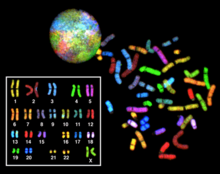Homologous chromosome
This article needs additional citations for verification. (November 2012) |
Homologous chromosomes (also called homologs or homologues) are chromosome pairs of approximately the same length, centromere position, and staining pattern, with genes for the same characteristics at corresponding loci. One homologous chromosome is inherited from the organism's mother; the other from the organism's father.[1] They are usually not identical, but carry the same type of information. When mitosis occurs, however, the daughter chromosomes carry exactly the same nucleotide sequence, assuming there are no errors during replication.

In diploid (2n) organisms, the genome is composed of pairs of homologous chromosomes. One chromosome of each homologous pair comes from the mother (called a maternal chromosome) and one comes from the father (paternal chromosome). Homologous chromosomes are involved in the process of meiosis in which they cross over.
Homologous chromosomes are similar but not identical. Each carries the same genes in the same order, but the alleles for each trait may not be the same. In garden peas, for example, the gene for pod colour on the maternal chromosome might be the yellow allele; the gene on the homologous paternal chromosome might be the green allele.
Duplicated chromosomes are made of two sister-chromatids, and the chromatids are attached by centromeres
References
- ^ Reece, Jane; Campbell, Neil (2002). Biology. San Francisco: Benjamin Cummings. ISBN 0-8053-6624-5.
{{cite book}}: CS1 maint: multiple names: authors list (link)
